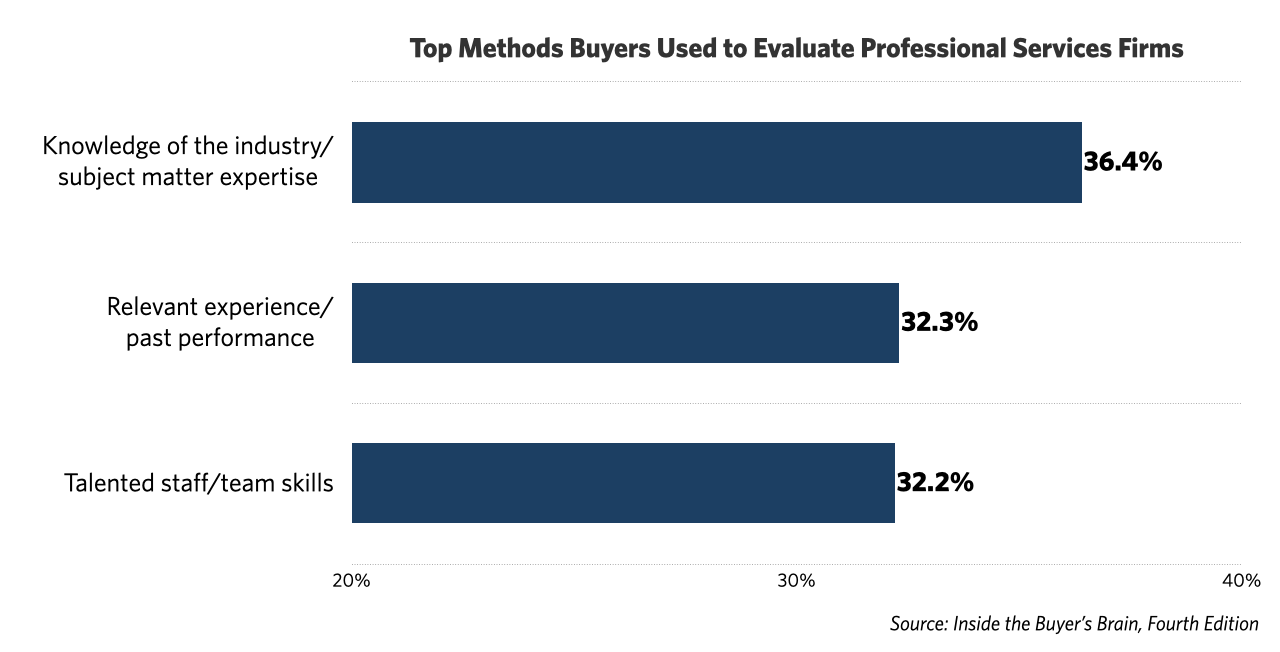Few would argue with the notion that building business relationships is critical in professional services. And while marketers typically focus on pricing, service strategy, and how to articulate their firm’s competitive position, the underlying intent is to build trust—and ultimately relationships.
An important research study by Hinge, Inside the Buyer’s Brain, found that most buyers who are trying to select a firm rely heavily on a firm’s relevant experience and expertise. These factors are represented by two of the top three bars in the chart below. This makes intuitive sense—if buyers know you are an expert in your service area, they are more likely to buy from you.

Like any personal relationship, business relationships require ongoing maintenance. Establishing a mutual benefit and channels of communication are important ingredients to success. In the long run, having close and trusting contacts will give you an edge, especially when other marketing tactics aren’t working.
Below are 5 keys to building and maintaining business relationships:
1. Routinely Reach Out to Important Contacts
Frequent and personalized outreach to every contact in your CRM is not only unrealistic, it rarely delivers the ROI expected. In other words, there is a time and place for broad-reaching (yet always informative and educational) email outreach. However, there is a strong case to be made for routinely reaching out to those contacts who are tightly aligned with the type of business you want to sell more of. Do your homework prior to reaching out—is there an opportunity to congratulate them on an addition to their service line, a new website, a new team member? Even if you are reaching out just to make them aware of a specific service or offering, craft your messaging in a way that is uniquely focused on them. Making your outreach first about them before it’s about you will enhance their experience and the overall relationship. And try to do this kind of outreach regularly. If you let too much time go by, your eventual contact will seem less genuine.
Finally, don’t ignore the power of LinkedIn. When executed properly, your social media strategy becomes the digital sister to in-person networking—and it can be a fast and efficient way to stay in touch. And try to engage with content that your contact creates or shares. It’s a great way to build goodwill and establish a professional relationship.
2. Offer Help Before You Ask for Help
Building business relationships doesn’t mean tapping into your resources whenever you need something. If the only time you ever contact a former client is when you have a new service offering, your gesture won’t seem authentic. Similarly, if you call a vendor only when you are looking for a good deal, don’t expect to get one.
Spend time figuring out how you can help your important business contacts. What value can you offer to spark the conversation?
3. Ask for Feedback
Instead of assuming your clients and vendors are happy, ask! Open communication is a basic component of any relationship.
When you ask your contacts how they feel, you promote a two-way conversation that can uncover areas for improvement. Some firms conduct client satisfaction surveys to gather feedback. But usually it’s best to pick up the phone and talk to your closest contact at a firm. If this is your top client, you want to make sure they are content.
This practice can also be an excellent business development tool. A peer of mine once told me a story. They asked for feedback and the end of a project, and the client replied “the overall project was great, but what I’m looking for now is XYZ. I wish your firm did that!”. As it turns out, they DID provide that service, it’s just that the client was unaware. A frustrating but all-too-frequent scenario in the world of professional services. Asking for feedback can go a long way toward avoiding situations like these.
4. Find Ways to Connect with Contacts in your Outer Circle
As new contacts enter your world, focus on building trust over time by using techniques such as an email newsletter. This practice helps keep your contacts apprised of the latest news and resources related to your business. Because you can’t personally interact with everyone in your email address book on a weekly basis, leveraging technology to do some of the work for you is a great option.
Email marketing is a powerful way to build trust and relationships. But if done wrong, it can easily have the opposite effect. Do not blast your list with untargeted emails or bottom-of-the-funnel hard offers. Instead, focus on sending educational, informative content that your audience will find relevant and practical. There are two types of mass or automated emails that fit in this category:
- Educational emails provide content that is meant to be informative. These emails give something of value to the reader without asking for anything in return. Because educational emails are highly valued by your audience, they should make up about 80% of the emails that you send out.
- Offer emails encourage the recipient to take a specific next step, such as downloading a guide, or connecting with you for a free consultation or demo. Offer emails help move your contacts to a deeper level of engagement. Although offer emails should account for the other 20% of your overall mix of emails, you wouldn’t want to send these until you’ve first created value for your audience. Offer emails should only go to folks who have already downloaded several pieces of your content. Unless they specifically requested it, you should never send an offer email to someone you just met at a networking event.
Here are a few tips we’ve discovered for highly effective email marketing:
- Make sure the look and feel of your email reflects your brand at every touchpoint.
- Ensure your email template is mobile friendly.
- Segment your distribution list so you can be strategic about which emails go to which list.
- Remember the 80/20 rule. No matter how many or how few emails you send out, the balance of them (80%) should be educational, while the remainder (20%) can be relevant offers.
- Make sure you have a way for people to unsubscribe.
- Consider the subject line carefully. To encourage high open rates, aim for 40 characters or less, and be very clear. Subject lines aren’t the place to be clever or leave too much up to the reader’s imagination. Just say what the email is about.
- Be aware of certain trigger words that can send your email straight into a recipient’s spam or junk folder. Words like “cheap” or “sale,” and sometimes even “free,” when placed in the subject line can signal the email is spam and it won’t get through the filter.
5. Educate and Relate, Don’t Tell and Sell.
If building relationships requires trust and credibility, then educating on a topic of relevance to your audience—as opposed to telling and selling and making it all about you—is a powerful way to build professional services relationships.
The most effective way to educate your audience is to produce a consistent flow of thought leadership. By definition, thought leadership marketing makes your expertise highly visible to the public. Regardless of whether your experts are publishing on your blog, in other publications, on social media, or elsewhere, their association with your firm makes you more visible to potential leads.
The depth of content required to build your profile as a high visibility expert means that potential buyers have the opportunity to learn a lot about your firm before making initial contact.
This level of visibility and expertise increases the trust and credibility of your firm. Think of it this way: there’s a reason that name brands at a grocery store sell better than store brands, despite their higher price tag. People trust what they know.
How Will You Improve the Way You Build Business Relationships?
Building business relationships is a two-way street. Too often people in the business environment treat everything as transactional. But like relationships outside of the workplace, strong business relationships are built over time as the two parties come to know, trust, and be helpful to one another.
But no two relationships are alike. That’s why it is essential in the modern work environment that you utilize different kinds of technology that can help you maintain relationships. Social media platforms like LinkedIn are great for engaging with the content others in your network are sharing. And on your end, digital newsletters and email marketing tools can help track your relationships and automate some of the process.
Of course, always consider your own experience. What business relationship-building techniques have worked for you?
We hope this article has stimulated some new ideas as you pursue new and stronger business relationships!
How Hinge Can Help
Let Hinge help you create and implement a research-based strategy to increase your firm’s visibility and growth. Hinge’s Visible Firm® Program is the leading marketing program for professional services firms that want to market themselves like industry leaders. Ask about it today!
Additional Resources
- Understand your buyers. Win more business. Read the latest findings from Inside the Buyer’s Brain, Fourth Edition, the biggest study of professional services buyers to date. It’s free!
- Join Hinge University and take the in-depth courses and read the step-by-step How-Tos to take your brand to a new level of sophistication and engagement.


